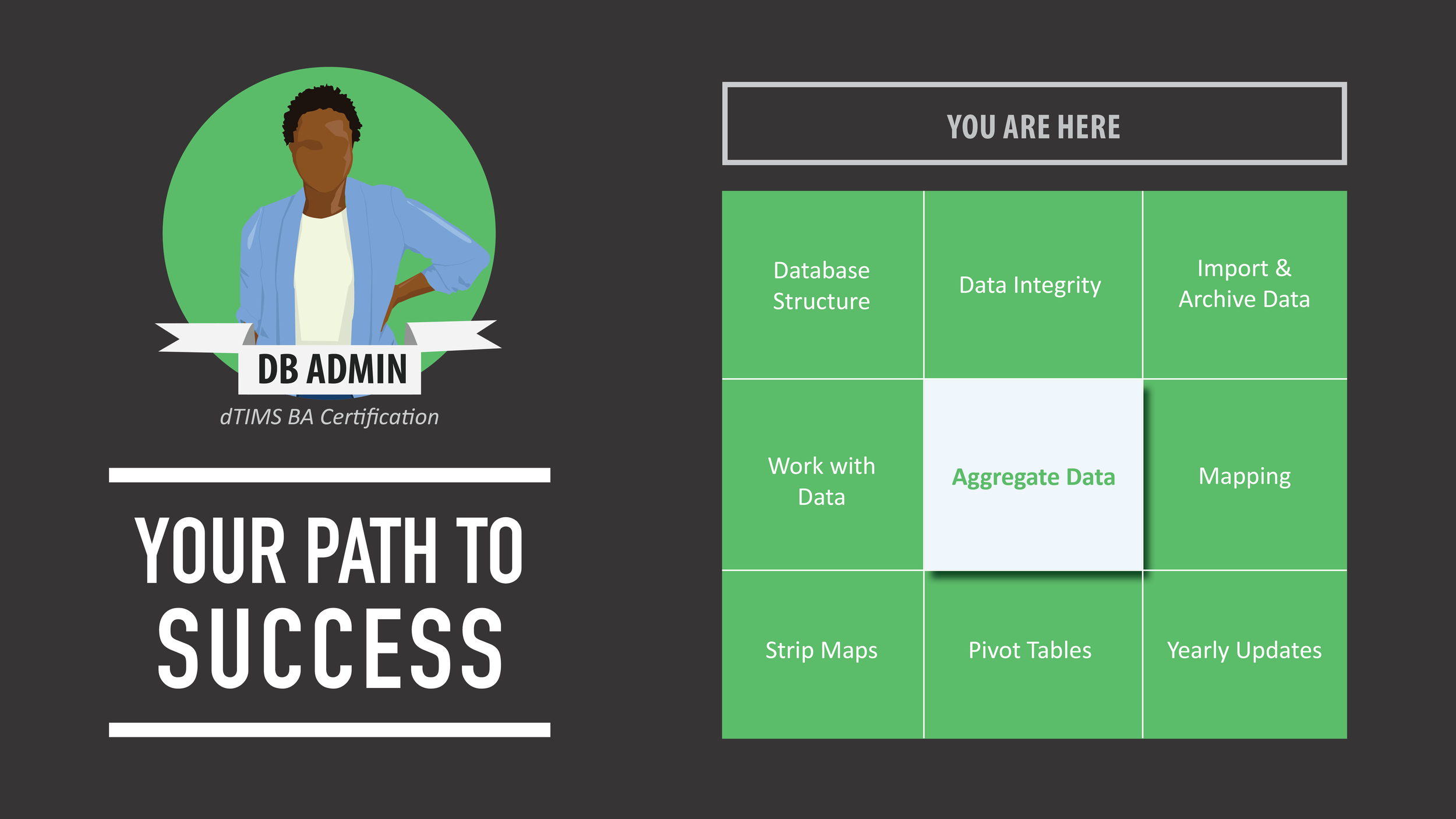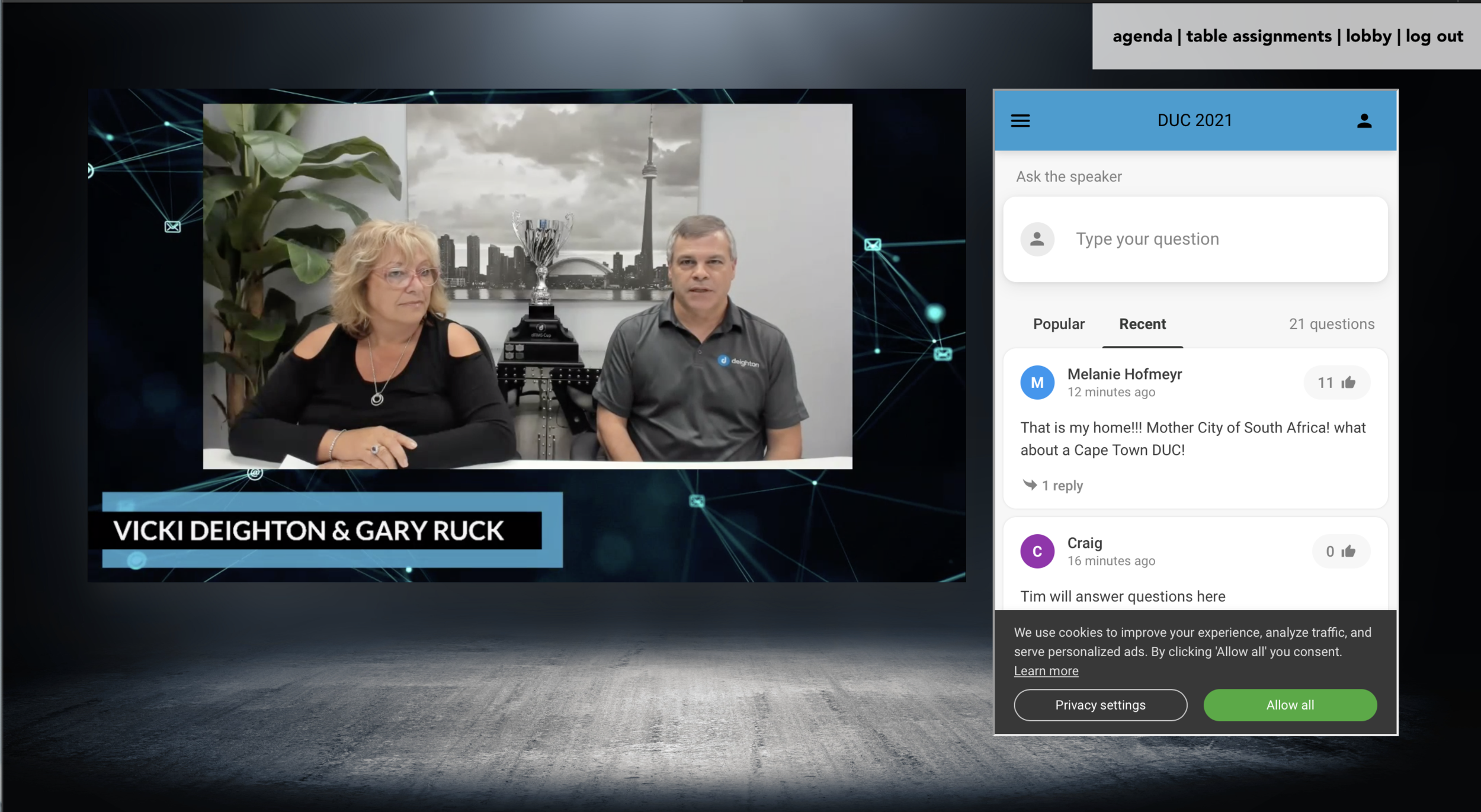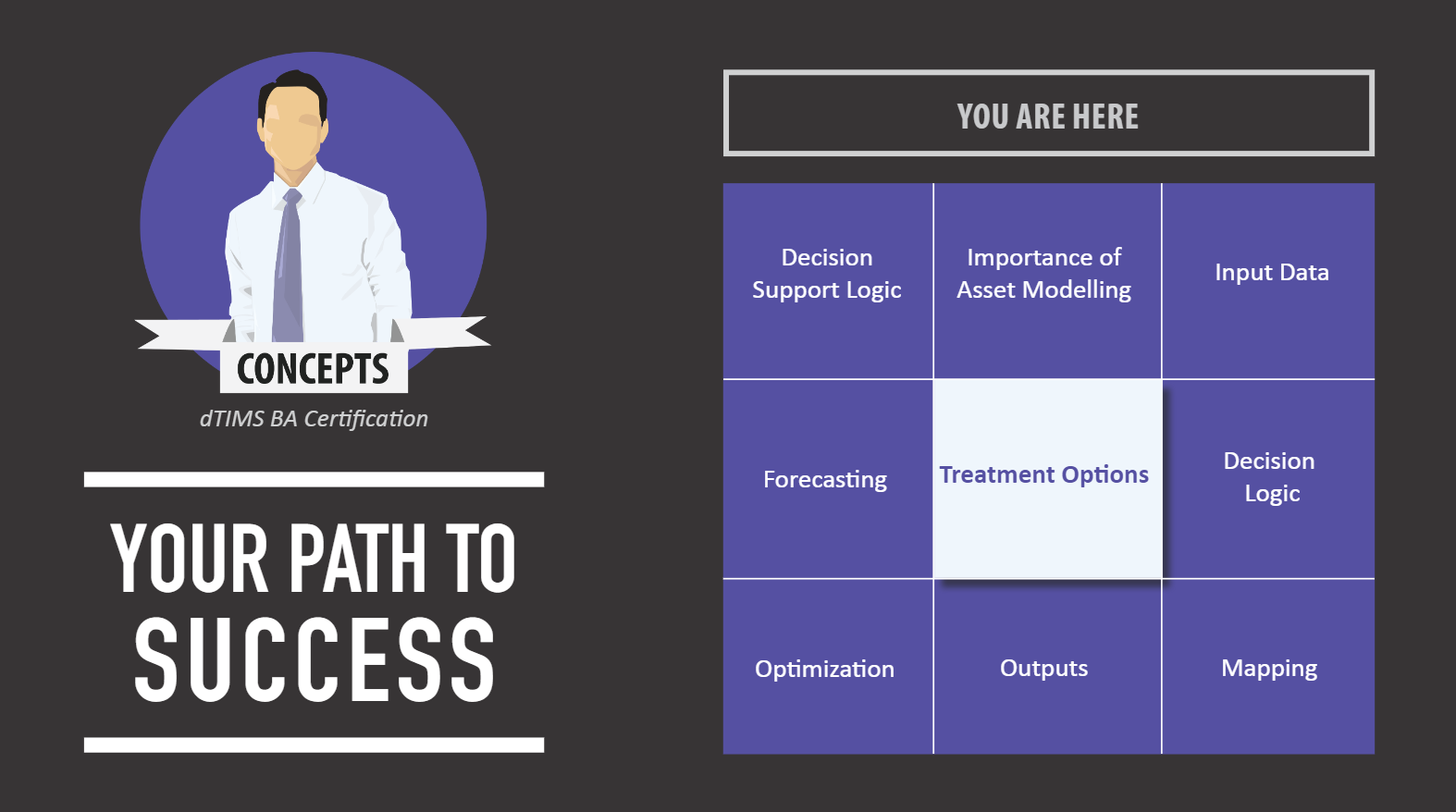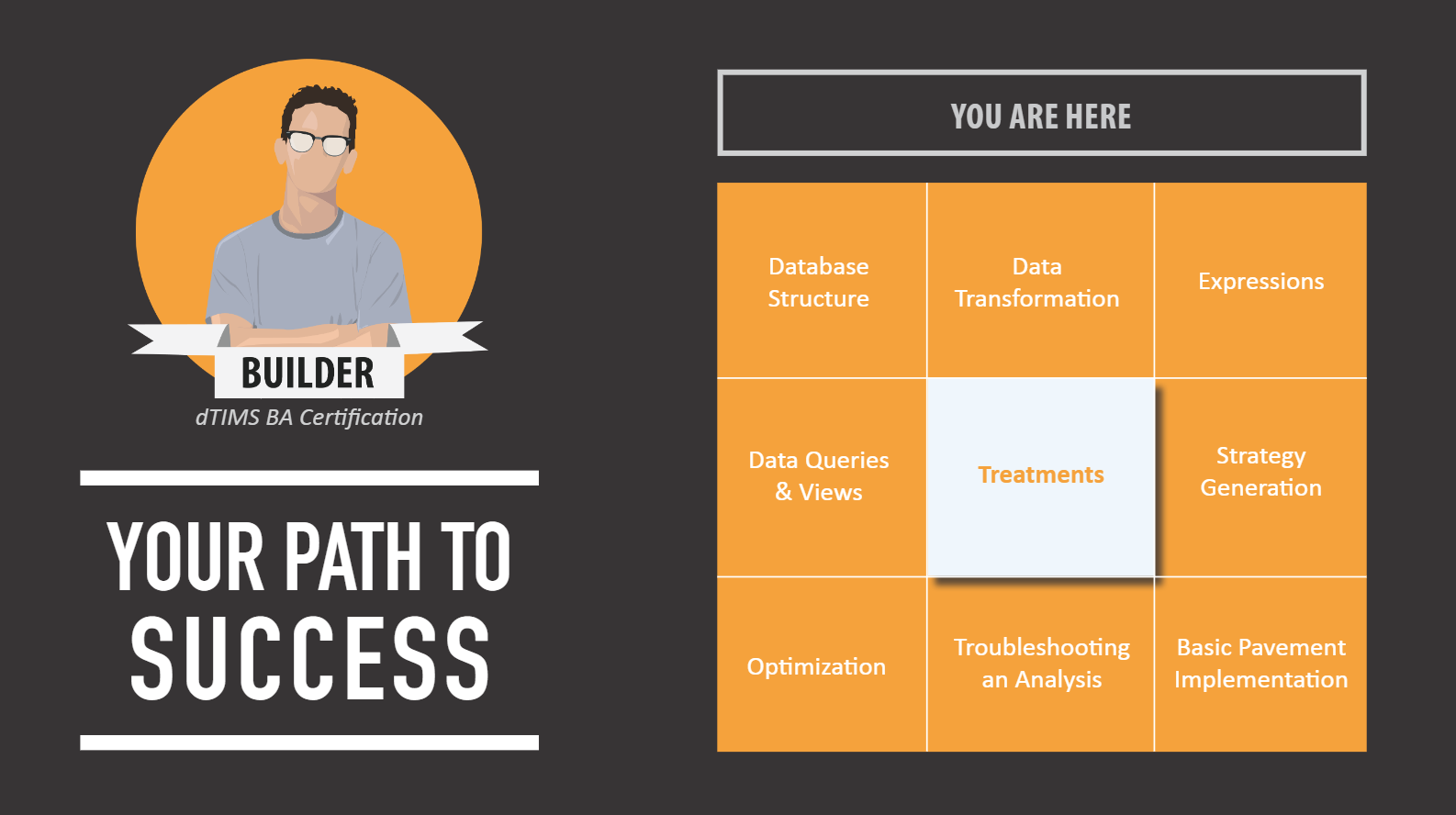DUC 2021 is the perfect opportunity to connect with asset management professionals from all over the world, explore up-and-coming trends in the industry, and receive hands-on dTIMS training. Once again, the conference will be a completely virtual experience. Although different, virtual conferences can be just as beneficial as in-person ones; so, we compiled a list of 5 tips to help ensure your DUC 2021 experience is successful!
What is DUC?
DUC is a three-day virtual event of networking and training. Recognized as the featured event for the dTIMS community, DUC focuses on asset management best practices and industry-specific thought leadership.
This is the Deighton User Conference (DUC).
For over 33 years, Deighton has hosted this annual event to connect like-minded individuals and open discussions of opportunities, development, and best practices in asset management from all over the world.
With the objective of uniting the dTIMS community, DUC offers a variety of benefits to individuals attending, no matter their skill level.
- Training – Enjoy dTIMS-specific training dedicated to enhancing your dTIMS knowledge, no matter your current level of expertise.
- Keynote Presentations - Hear from international industry experts on asset management best practices, innovation, and opportunities during engaging keynote sessions.
- Case Studies - Learn how other agencies are using dTIMS and discover alternative ways of approaching your own projects.
- Networking – Collaborate with fellow asset management professionals during session breaks and virtual networking sessions.
- International Perspective - Exchange ideas and build one-on-one relationships with asset management professionals from around the world, including: North America, Mexico, Europe, South Africa, New Zealand, Australia, and more.
- Practical Knowledge - Gain practical dTIMS knowledge from DUC presentations that you can apply to your own agency’s projects back home.
Similar to last year, DUC will be a mostly virtual experience. DUC2022 will focus on bridging the gaps in a virtual world and reconnecting you with the vast network of asset management professionals. Follow us on social media for weekly reveals on DUC2022 speakers, sessions, and more!
Secure your tickets while you still can.
DUC2022 - Uniting the dTIMS Community. We can't wait to see you there!
dFRAG Mini-Course Released!
dFRAG - Automatic Sectioning
We are proud to launch the new dFRAG dTIMS BA Mini-Course!
In this mini-course we will explore automatic sectioning in dTIMS, which is achieved using a process called dFRAG. dFRAG allows you to define the conditions under which adjacent sections of an asset can be combined into one larger section. Re-sectioning assets in this way can assist in visualization, budgeting, and planning of construction projects.
Upon completion of this mini-course, you will be able to perform automatic sectioning by creating and executing a dFRAG Object, and be able to perform the following:
Create the Database Expressions required to provide a dFRAG Object with Road and Direction specifications
Create the dFRAG Expression that specifies the conditions in which two elements should be combined
Create the Dataview needed by the dFRAG Object
Add attributes (columns) as necessary to a table or Dataview
Get Certified
This mini-course is part of the dTIMS BA Analyst Stream in the Deighton University. Did you know by succesfully completing each mini-course you can become certified as a dTIMS BA - Analyst? Check out the other courses that make up the dTIMS BA Analyst stream below.
Coming Next Month!
Next month we will release the Expressions mini-course, part of the dTIMS BA Analyst Stream. Expressions are a fundamental part of how dTIMS functions. They are used to calculate data you don't have, to automatically segment your network, and to guide how your life cycle cost analysis generates strategies. This mini-course introduces you to the three expression types and where you would use them.
Construction Program Mini-Course Released!
Construction Program
We are proud to launch the new Construction Program dTIMS BA Mini-Course!
This mini-course explores the dTIMS Construction Program Report. After executing an analysis and optimization, the Construction Report is the most significant report you will generate, as it captures future work recommended by dTIMS that your agency is scheduled to complete.
Upon completion of this mini-course you will be able to generate a construction program, and be able to perform the following:
Customize a construction program
Generate a construction program
Export a construction program
Explore how you can map a construction program
Get Certified
This mini-course is part of the dTIMS BA Analyst Stream in the Deighton University. Did you know by succesfully completing each mini-course you can become certified as a dTIMS BA - Analyst? Check out the other courses that make up the dTIMS BA Analyst stream below.
Coming Next Month!
Next month we will release the Expressions mini-course, part of the dTIMS BA Analyst Stream. Expressions are a fundamental part of how dTIMS functions. They are used to calculate data you don't have, to automatically segment your network, and to guide how your life cycle cost analysis generates strategies. This mini-course introduces you to the three expression types and where you would use them.
Data Integrity Mini-Course Released!
Data Integrity
We are proud to launch the new Data Integrity dTIMS BA Mini-Course!
This mini-course, developed with help from our partners Infrastructure Decision Support (IDS) New Zealand, explains the value of good, clean data.
The last few mini-courses that we launched in the Database Administrator Stream explored data types and how to manipulate them within dTIMS. Now we will explore how we can ensure our data is reliable for our analysis. During this mini course, you will learn the difference between good and bad data, what to look out for, and how to improve your datasets.
Upon completion of this mini-course you will be able to:
- Understand where and how to focus your data cleaning efforts
- Be able to recognize data inconsistencies and how to deal with them
- Be able to apply assumptions to fill gaps in your datasets
Get Certified
This mini-course is part of the dTIMS BA DB Admin Stream in the Deighton University. Did you know by succesfully completing each mini-course you can become certified as a dTIMS BA - Database Administrator? Check out the other courses that make up the dTIMS BA DB Admin stream below.
Coming Next Month!
Next month we will release the Budget Charts dTIMS BA Analyst Stream mini-course. This mini-course explores dTIMS Budget Reports.
Database Structure Mini-Course Released!
Database Structure
We are proud to launch the new Database Structure dTIMS BA Mini-Course!
This mini-course will explain the basic concepts and operation of the dTIMS Database. It will explore data types that are commonly input into dTIMS, and the database structure created to store the corresponding input data.
Upon completion of this mini-course you will be able to:
- Identify different asset data types
- Understand the building blocks of your database and how they relate
Get Certified
This mini-course is part of the dTIMS BA DB Admin Stream in the Deighton University. Did you know by succesfully completing each mini-course you can become certified as a dTIMS BA - Database Administrator? Check out the other courses that make up the dTIMS BA DB Admin stream below.
Coming Next Month!
Next month we will release the Data Integrity dTIMS Mini-Course. This mini-course was created with our partners IDS New Zealand and will explore data integrity, data checks, and data cleaning.
Yearly Updates Mini-Course Released!
Yearly Updates
We are proud to launch the new Yearly Updates dTIMS BA Mini-Course!
For accurate analysis results, the dTIMS data that you use must be current and precise. This concept is referred to as data integrity. Data integrity refers to the accuracy and consistency of stored data. The term is often interchanged with data quality. Inaccurate data in dTIMS leads to an inacurrate analysis. You always need to keep your infrastructure network data accurate and up-to-date.
This mini-course will guide you through the items you will need to check and update on a yearly basis.
Upon completion of this mini-course, you will learn how to:
- Update asset information
- Update analysis parameters
- Update analysis sets
- Update budget Scenarios
Get Certified
This mini-course is part of the dTIMS BA DB Admin Stream in the Deighton University. Did you know by succesfully completing each mini-course you can become certified as a dTIMS BA - Database Administrator? Check out the other courses that make up the dTIMS BA DB Admin stream below.
Coming Next Month!
Next month we will release the Database Structure dTIMS Mini-Course. Upon completion of this mini course, you will learn the basic concepts and operation of the dTIMS Database.
Two Mini-Courses on Data Visualization Released
New to the Deighton University
We are proud to launch two new mini-courses available at Deighton University this week!
The mini-courses Strip Maps and Pivot Tables focus on data visualization in dTIMS BA.
Learn more about each mini-course below, and continue your dTIMS Learning today!
Strip Maps
This mini-course explores Strip Map Reports in dTIMS BA. Strip maps are a useful reporting tool for viewing historical data for trends. Data is represented in layers and each layer can be used to show important parts of an asset. This allows for in-depth analysis and specificity of requirements in any given project.
Upon completion of this mini-course, you will learn how to use strip maps to view the following:
Historical data in layers
Attribute and table data
Construction program
Lane data
Pivot Tables
This mini-course explores dTIMS Pivot Tables. A pivot table can automatically sort, count, total, or apply a calculation to selected data. Once created, they can be used as a report to share. This data visualization tool allows you to easily summarize data in an existing dTIMS BA table.
Upon completion of this mini-course, you will be familiar with:
- Pivot table concepts
- Pivot table heat maps
- Pivot Table bar charts
- Sending a pivot table link to someone else
Did you know by successfully completing each mini-course in this stream you can become certified as dTIMS BA - Database Administrator? Check out our website to explore the other courses that make up the dTIMS BA DB Admin Stream.
Coming Next Month!
Next month we will release the Yearly Updates dTIMS Mini-Course. This mini-course will explore the tasks that you should perform on a yearly basis to ensure your dTIMS data is up-to-date.
Two Mini-Courses in One Week!
New to the Deighton University
We are proud to launch two new mini-courses available at Deighton University this week!
Continuing down the path to success in our dTIMS BA User Stream, Export Results has officially launched as our sixth mini-course. Additionally, work on developing our dTIMS BA Concepts Stream has begun, in partnership with Infrastructure Decision Support (IDS) New Zealand, and this week we get to launch the second mini-course - Data Inputs.
Learn more about each mini-course below, and continue your dTIMS Learning today!
Export Results
This mini-course explores how to export dTIMS strategy information so you can manipulate data in reports outside of dTIMS.
Upon completion of this mini-course, you will be able to:
- Create an export strategy object (including segments, strategies, and treatments)
- Create and export Queries to Excel
Did you know by successfully completing each mini-course in this stream you can become certified as a dTIMS BA - User? Check out the other courses that make up the dTIMS BA User stream below.
Data Inputs
This mini-course explores the data requirements for asset inventory, utilization, condition, and asset performance. We will also explore the concepts of summarization.
Upon completion of this mini-course, you will be able to:
Understand the data requirements for a decision support system
Understand that there is no "one size" fits all approach when it comes to data collection
Know what to think about when deciding what data to collect
Understand the importance of homogenous analysis sections
Did you know by successfully completing each mini-course in this stream you can become certified in dTIMS BA - Concepts? Check out our website to explore the other courses that make up the dTIMS BA Concepts Stream.
Coming Next Month!
Next month we will release the Budget Charts dTIMS Mini-Course. This mini-course will explore understanding the use of each Budget Chart and learning to interpret the information in these reports.
Review and Adjust Mini-Course Released!
Review and Adjust
We are proud to launch the new Review and Adjust dTIMS BA Mini-Course!
There are times where you may need to override the dTIMS recommended program, which may be due to unforeseen events that are not factored into the generated strategies. dTIMS Review and Adjust enables you to do this.
This mini-course explores reviewing the results of your analysis and potentially making changes to dTIMS recommended strategies. The course will enable you to understand the analysis results generated by dTIMS.
Upon completion of this mini-course you will be able to:
- Interpret analysis results
- Review strategies by element
- Reschedule Treatments
- Reschedule Projects
Get Certified
This mini-course is part of the dTIMS BA User Stream in the Deighton University. Did you know by succesfully completing each mini-course you can become certified as a dTIMS BA - User? Check out the other courses that make up the dTIMS BA User stream below.
Coming Next Month!
Next month we will release the Export Results dTIMS Mini-Course. This mini-course will explore how to export dTIMS strategy information to allow you to manipulate this data in reports outside of dTIMS.
Generate Bridge Reports from dTIMS
In Part I of this three-part blog series we discussed Structuring your Bridge Database in dTIMS. In Part II we explored Life Cycle Cost Modelling of Bridges. In this blog post (Part III) we will talk about dTIMS Bridge Management Reports.
Reporting in dTIMS
The combination of performance prediction models based on your treatment catalog and budgetary constraints results in a recommended construction program report. This report is communicated through dTIMS in different types of reports.
Example Treatment Catalogue for bridge assets
dTIMS Reports enable you to consolidate data after you apply lifecycle cost methodology to assess the future of your network. Bridge reports are needed on the technical or object level, and the network level in order to present results to high-level decision makers and managers. dTIMS offers many unique reports based on the specific configuration used in the analysis, such as condition classes, condition categories, variables, and so on.
dTIMS is able to incorporate user specific reports such as dashboards at the technical level, but also the strategic or network level. Let's explore the bridge reporting functionality in dTIMS.
Review and Adjust
Once you have excuted a bridge analyiss, Review & Adjust reports provide support for section or object related results. We have the option to look at results element by element, giving us results which are generated out of different condition and treatment options. We can see all the potential bridge strategies, and which is the optimal solution for the specific budget scenario. We can also view all the treatments on a specific element and the condition prognosis of the element.
Example Review & Adjust Reports
Mapping
We can load a map showing our bridge locations, condition levels, and more. You also have the option to access a bridge in the field through Google Street View. You can view a bridge from multiple angles or approaches.
Example Bridge asset on a map and what it looks like in the field.
Contruction Program
The construction program report allows you to export the current selected strategy for each bridge element included in the analysis set. This report contains the recommended treatments for your bridges for each year. You can also export these reports into a spreadsheet or database application so you can develop your construction program.
Example 50-year Bridge Construction Program
Budget Reports
- Budget Charts - After optimization, you can use these charts to review and compare your budget scenarios. Some charts allow you to review details for a single budget scenario, while others allow you to compare multiple budget scenarios. Available charts include: Average Condition (can be used with multiple budget scenarios), Condition Distribution, Travel Distribution, Treatment Costs, Treatment Lengths, Program Costs, and Length in Backlog (can be used with multiple budget scenarios)
- Budget Comparisions - After optimization, you can use the budget comparison charts to review and compare your budget scenarios. These charts allow you to compare multiple budget scenarios. Available charts include: Average Condition, and Length in Backlog.
Example Program Cost and Treatment Cost Budget Charts
Example Budget Comparison Charts, including: Average Condition and Length in Backlog
Dashboard Reports
A dashboard is a combination of multiple visual elements like charts, text, and values on one page. The elements can be interrelated with each other. The data used to create those reports can be pulled out directly from dTIMS. Each time you conduct an analysis, the data shown in a dashboard will be updated accordingly.
The advantage of having a dashboard is that it can be easily shared with other users, such as managers or clients who do not have access to dTIMS. All you need to do is to publish the dashboard and share the link with your colleagues.
In the example below, you can see historical condition data from an individual structure. On the left you can see the historical condition data of a bridge, including details regarding areas of the bridge, the construction year, the object type, and the number of bearings and corresponding type. Component type material and geometry is displayed in the middle, and the current overall condition of the bridge is displayed on the right. Along the bottom there is a list of the component condition data collected during the annual bridge inspections, as well as a map displaying the location of the structure.
Dashboard example of a single bridge element
Example Power BI Dashboard added as a custom report in dTIMS
Example dashboard created to manage tunnel network
Final Word
This is a short look at bridge reporting in dTIMS. Flexibility is key when choosing an asset management software that can accommodate all your reporting needs. dTIMS offers many options to report on the current and future condition of your bridge network.
Aggregate Data Mini-Course Released!
Aggregate Data
We are proud to launch the new Aggregate Data dTIMS BA Mini-Course!
Data Transformation in dTIMS is the process of aggregating infrastructure network data values from different sections. You need to transform data because you collect and store data differently than the way you want to access data, as shown below.
Conceptual view of multiple data types that need to be aggregated
Upon completion of this mini-course you will be able to:
- Name and differentiate between the three different types of dTIMS transformations
- Reorganize data into larger chunks for better analysis
- Explain how each transformation works – where does the source information come from, and where does the output reside?
- Analyze a scenario to select the appropriate transformation for the output required
- Create a transformation
- Hypothesize the output of the transformation
- Transform data for analysis and review
Get Certified
This mini-course is part of the dTIMS BA DB Admin Stream in the Deighton University. Did you know by succesfully completing each mini-course you can become certified as a dTIMS BA - Database Administrator? Check out the other courses that make up the dTIMS BA DB Admin stream below.
Coming Next Month!
Next month we will release the Review and Adjust dTIMS Mini-Course. Often you may need to override the dTIMS recommended program. This may be due to unforeseen events that are not factored into the generated strategies. dTIMS Review and Adjust enables you to do this.
Call for Presentations - DUC2022
The 2022 Deighton User Conference (DUC2022) connects asset management professionals from all over the world and is the perfect opportunity to share your case study, innovative solution, or dTIMS story with Deighton's global community.
Present at DUC2022
Our preparations for DUC2022 have already begun, and we are giving you the opportunity to participate and help make DUC2022 a success!
Does your organization have an industry success story you'd like to share? Are you passionate about discussing new developments in the infrastructure asset management industry? Do you have an innovative solution to an industry problem?
If you are interested in sharing your knowledge and presenting at DUC2022, we would love to hear from you! We are accepting abstract submissions until February 1, 2022. Selections will be made after this date, and we will contact the successful applicants.
Potential Topics
Potential topics for DUC2022 include:
- Success Stories - Are you willing to share your agency's dTIMS story? dTIMS rapid-fire case studies allow you to share your successes with everyone. Start with your agency overview, talk about the challenges you faced, then conclude with your solution and results. We will provide the template.
- Innovative Solutions - Is your agency thinking differently about how you manage assets? Are you adopting innovations in data collection techniques? Are you using dTIMS to manage a non-traditional asset class? Are you currently implementing a project that is pushing the limits? Share your innovative projects with the dTIMS Community.
- Integrations - Aside from the ability to integrate multiple assets in dTIMS, your agency may include unique integrations such as social and environmental indicators, climate, noise, external enterprise systems, and more. Share your story.
Submit Your Abstract
To submit an abstract for consideration, please include the following information:
Presenter Name and Job Title
Company Name and Address
Presentation Title
Presentation Abstract (200 words max)
Optional Link to Supporting Documents
Include a focus on how you or your company used dTIMS technology in your presentation. You can submit directly using the form on our website, or email your submission to info.web@deighton.com. The deadline to submit is February 1, 2022.
Work with Data Mini-Course Released!
Work with Data
We are proud to launch the new Work with Data dTIMS BA Mini-Course!
You have large volumes of data in a raw format. Viewing the data as information is essential to making decisions. In this mini-course, we will explore three ways of manipulating data to view and present in reports, namely Table Grids, Data Views, and Queries.
Learn how to manipulate data in your tables
Through this mini-course you will learn the basic concepts and operation of the dTIMS Database. You will start creating a database structure, populating the database with corresponding data, and learn how to transform data for analysis and review.
Upon completion of this mini-course, you will be able to:
- Edit location & data, sort, filter, and group tabular data to view
- Create data views to work with a subset of your database
- Create different query types
Get Certified
This mini-course is part of the dTIMS BA User Stream in the Deighton University. Did you know by succesfully completing each mini-course you can become certified as a dTIMS BA - User? Check out the other courses that make up the dTIMS BA User stream below.
Coming Next Month!
Next month we will release the Aggregate your Data dTIMS Mini-Course. Data Transformation in dTIMS is the process of aggregating infrastructure network data values from different sections. You need to transform data because you collect data and store data differently than the way you want to analyze data. In this mini-course, you will learn how to transform data for analysis and review.
Life-Cycle Cost Analysis for Bridges in dTIMS
New to the Deighton University!
Import and Archive Data
We are proud to launch the new Import and Archive Data dTIMS BA Mini-Course!
Importing data is the process of retrieving data from sources external to dTIMS and inserting it into dTIMS tables. You may add or modify individual records in a data table manually, however, when you receive large volumes of data, such as a data collection file, you will need an automatic process such as import to save time and ensure accuracy.
Upon completion of this mini-course, you will learn the basic concepts of populating your dTIMS database with data through the Import Process. Along the way, we will:
- Explore different import methods
- Learn how to import data
- Troubleshoot errors in the import process
Get Certified
This Mini Course is part of the dTIMS BA User Stream in the Deighton University. Did you know by succesfully completing each mini-course you will become certified as a dTIMS BA - User? Check out the other courses that make up the dTIMS BA User stream below.
Coming Next Month!
Next month we will release the Working with Data dTIMS Mini-Course. In this mini-course, you will explore some of the methods available to you for working with your table data. Upon completion you will be able to sort and group in a table grid, create a data view, and query your database.
DUC 2021 Recap
This year our annual Deighton User Conference (DUC) welcomed asset management professionals from 70 different agencies representing 16 different countries around the world. Our three days together included thought-provoking keynotes by industry experts, dTIMS releases and demos, case studies from around the world, and networking opportunities and activities.
“Welcome to DUC” introduction with Vicki Deighton and Gary Ruck on the main stage.
Sessions
DUC 2021 offered a wide variety of keynotes, breakout sessions, and discussion panels. The opening keynote gave us a retrospective look at Deighton and our client history and development over the years. The session wrapped up with a look to the future with the 2021 dTIMS Release trailer.
On the final day, we heard from industry experts all around the world in the State of the Industry Panels. The panel ran twice with different speakers to accommodate both the North American and South Pacific time zones.
Picking up where we left off at DUC 2020, we continued an interactive discussion with Deighton President Rob Piane about the impacts of COVID-19 on our organizations and how to collectively move forward.
Case Studies
DUC 2021 featured client case studies from around the world including Vermont, New Zealand, and Belgium.
On Day 1 of DUC, Elke Beca presented on a collaborative project in New Zealand.
This project was an exceptional visionary challenge, bringing together an entire industry to answer Waka Kotahi’s "billion-dollar" question - “How much investment is needed to maintain our 11,039 km New Zealand State Highway network over the next three years and beyond?”. The Project, led by Infrastructure Decision Support (IDS), needed industry-wide support, buy-in and collaboration to deliver Waka Kotahi’s project goals. Between May 2019 and March 2021, the best technical engineering minds in New Zealand came together, sharing knowledge and expertise, that not only met Waka Kotahi’s goals and specified budget, but far exceeded what anyone believed was possible.
Because this project was created by industry people, it reflected their needs and allowed everyone from frontline road maintenance contractors through to high level, senior execs, and elected officials to understand the rationale behind Waka Kotahi’s investment strategy and take ownership of it. This presentation stepped through the project from model development through to on the ground implementation, showcasing the benefits of nationwide collaboration.
dTIMS Cup Winner
Congratulations Claire-Louise Bode for winning the dTIMS Cup at DUC 2021! The prize is a free DUC ticket to a future DUC event and a donation of $500.00 given to a charity of the winners choice. The winner's name will also be engraved on the dTIMS Cup with all of the other winners from past DUCs.
The gamification at DUC consists of series of polls and questions with points assigned that attendees can participate in during sessions throughout the event. This year, points were also given to winners at our virtual casino activity and scanning codes for points were included in our daily DUC emails during the event.
DUC 2022
Be on the lookout for information about DUC2022 on all of our different platforms! Want to be the first to know about everything DUC2022? Visit our website and join the mailing list to receive exclusive offers and promo codes.
Deighton University for dTIMS eLearning
A lot has changed in the last year and a half. Nowhere is that more apparent than the way we learn. Consider the way our kids attend school now and the way we onboard new employees. While online learning has been around for years, it is now becoming mainstream and is widely accepted by most.
At Deighton, we started on our eLearning Journey just before the onset of the COVID pandemic. At DUC 2020, we launched the Deighton University with two offerings, dTIMS BA Concepts, and dTIMS BA Practical.
While developing our eLearning content and investigating other eLearning success stories, we took the time to refine our eLearning methodology. We are now developing smaller dTIMS Mini-Courses based on three specific learning streams, as outlined below.
The dTIMS Mini-Course
A Mini-Course is a small, bite sized learning opportunity of roughly 20 to 30 minutes in length. Each mini course will contain corresponding content, a use case, and a quiz. Additionally, each mini course will contain 70 to 80% instructor face time (time where the instructor is on-screen).
Each mini-course we develop will fall into one of three streams: Concepts, User, and Builder. Completing all of the mini-courses in one specific stream entitles you to a dTIMS BA Certificate.
New This Month
Each month you will see at least one mini-course launched. We are excited to release Decision Support Systems - Part I today! This mini-course was co-developed with our eLearning partners IDS Limited.
In this mini-course, you will explore the Decision Support System and the following points:
Why we need tools to help us predict the future
What a Decision Support System looks like
Key components of a Decision Support System and how they interact
Requirements, inputs, and assumptions that will give you the context needed to continue on your modeling journey
Coming Next Month
Watch for Loading and Archiving Data in August! In this mini-course you will explore the basics of importing data into your dTIMS Database. Upon completion you will able to import data and archive historical data.
5 Tips to Enhance your DUC 2021 Experience
DUC 2021 is the perfect opportunity to connect with asset management professionals from all over the world, explore up-and-coming trends in the industry, and receive hands-on dTIMS training. Once again, the conference will be a completely virtual experience. Although different, virtual conferences can be just as beneficial as in-person ones; so, we compiled a list of 5 tips to help ensure your DUC 2021 experience is successful!
What is DUC?
DUC is a three-day virtual event of networking and training. It represents the flagship of the dTIMS community. It focuses on asset management best practices.
This is the Deighton User Conference (DUC).
A session on the virtual main stage at DUC 2020.
For 33 years, Deighton has hosted this annual event to connect like-minded individuals and open discussions of opportunities, development, and best practices in asset management from all over the world.
With the objective of uniting the dTIMS community, DUC offers a variety of benefits to individuals attending, no matter their skill level.
- Training – Enjoy dTIMS specific training dedicated to enhancing your dTIMS knowledge, no matter your current level of expertise.
- Keynote Presentations - Hear from international industry experts on asset management best practices, innovation, and opportunities during engaging keynote sessions.
- Case Studies - Learn how other agencies are using dTIMS and discover alternative ways of approaching your own projects.
- Networking – Collaborate with fellow asset management professionals during session breaks, virtual networking sessions, or after-hours social events.
- International Perspective - Exchange ideas and build one-on-one relationships with asset management professionals from around the world, including North America, Mexico, Europe, South Africa, New Zealand, and Australia to name a few.
- Practical Knowledge - Gain practical dTIMS knowledge from DUC presentations that you can apply to your own agency’s projects back home.
- After Hours Events - After a busy day at DUC, relax and enjoy the online casino, duelling pianos, photo booth, or our virtual networking lounge.
Just like last year, DUC will be a completely virtual experience. DUC 2021 will focus on bridging the gaps in a virtual world and reconnecting you with the vast network of asset management professionals. Follow us on social media for weekly reveals on DUC 2021 speakers, sessions, and more!
Secure your tickets while you still can.
DUC 2021 is just around the corner, and we can’t wait to see you there!













































